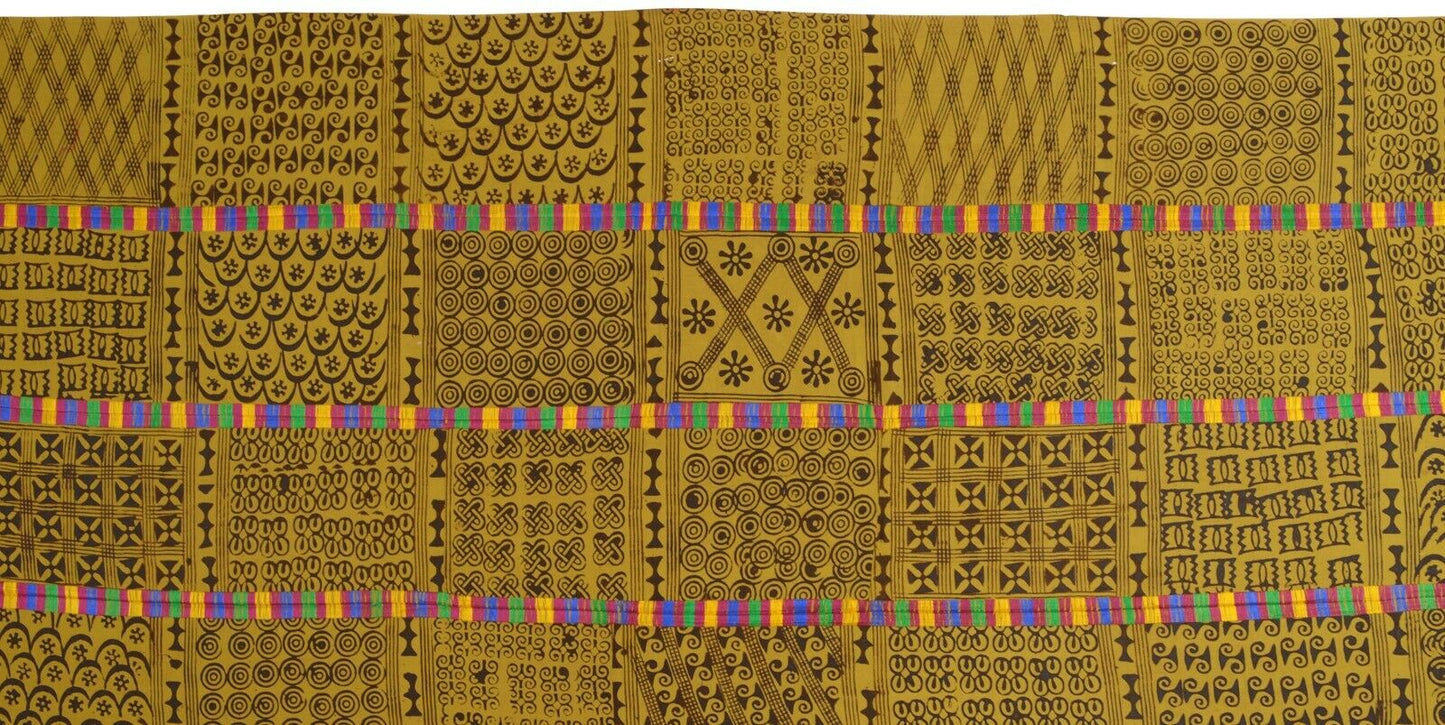Tribalgh
Hand Stamped Adinkra Cloth – 1970s “Man” Size, Authentic Ashanti Heritage
Hand Stamped Adinkra Cloth – 1970s “Man” Size, Authentic Ashanti Heritage
Item number:
SKU:SD-30154
Check shipping cost
Check shipping cost
FREE DHL shipping ( 2 - 4 working days ) to all over the world.
We combine shipping on multiple purchases!
Couldn't load pickup availability
Hand Stamped Adinkra Cloth – 1970s “Man” Size, Authentic Ashanti / Akan Heritage
This beautiful, vintage Adinkra cloth was hand painted, hand embossed and carefully embroidered in Ghana during the 1970s. Each Adinkra symbol was stamped by hand using carved calabash blocks and dyed with natural bark dye from the badie tree, thickened with iron slag over several days. The cloth remains in good condition for its age with some wear, one repair and a few small holes adding to its authentic story and cultural charm.
- Size: 135" x 82" (342 cm x 208 cm)
Detailed Description of This Adinkra Cloth
This hand stamped Adinkra cloth features the traditional stamping technique using calabash blocks created by skilled Ghanaian artisans. Natural dye made from the bark of the badie tree was heated with iron slag for three to five days to yield a deep, lasting hue. The artist stamped multiple symbolic Adinkra motifs to convey meaning. You will notice signs of its long life and emblematic use. Adinkra cloths of this kind were not hand woven. They were hand stamped and painted, making each piece unique.
Adinkra cloths have been used by the Ashanti and Akan people of Ghana for centuries. These textiles appear at funerals, ceremonial events and celebrations. Different symbols offer messages about wisdom, strength, unity and human experience. Symbols and colours carry deep spiritual meaning and tell stories in a visual language. Cloths used for mourning often feature darker colours like indigo and black while festive cloths show brighter hues.
Adinkra was originally a funerary cloth worn by royalty and leaders and later became a cultural staple across many ceremonial contexts. The design of this cloth may echo the legend of Nana Kofi Adinkra. This Gyaman king was captured by Asantehene Bonsu Panyin during a battle. Tradition holds that Nana Adinkra wore patterned cloth to show sorrow when taken to Kumasi. This legend inspired the name “Adinkra” for the symbol‑based cloths stamped to express grief yet cultural identity.
About Adinkra Symbols, Materials and Tradition
What are Adinkra symbols? These are stylized motifs representing proverbs, history, ethics and philosophy. Common symbols include Sankofa (go back and fetch it), Gye Nyame (except for God) and Dwennimmen (ram’s horns, humility and strength).
Symbolic meanings and colours: Colours vary by purpose. Black, red and indigo mark mourning. Earth tones and vibrant shades mark life events, joy and social status. Symbols carry meaning according to Akan proverbs and life lessons. Wearing specific symbols was a way to convey status, wisdom or aspiration.
Materials and techniques: The cloth base is cotton or similar material from local Ghanaian trade supplies. Symbols were carved into calabash or wood stamping blocks. Dye derived from badie tree bark was boiled then thickened with iron slag over days. Each motif was stamped by hand in sequence to create a complete design. After stamping, artisans painted and embroidered details.
Use in Ashanti funerals and celebrations: Adinkra cloths were worn by mourners of high status at funerals to express grief and ancestry. At celebrations they broadcast cultural values, stories and aspirations. The cloth was a visible message of identity, morality, social rank and community membership.
History of Adinkra cloth in Ghana: The tradition originated with the Gyaman kingdom and was adopted by the Ashanti in the early 19th century. Cloth stamping and use expanded beyond royalty to artisans, farmers and community events. Today Adinkra cloth is a national and global symbol of Ghanaian culture and expression.
This cloth from the 1970s is a rare, expressive piece of cultural heritage. It has aged with charm and offers insight into the creative tradition of Adinkra stamping. It is hand stamped not hand woven. Let this authentic Ashanti Adinkra funerary or celebratory cloth bring history and meaning to your collection.
Explore TribalGH’s collection of Adinkra stamping blocks
Discover jewelry featuring Adinkra symbols
Read our educational blogs about Adinkra symbols
Share



Very happy with this purchase. It has stamps that I purchased from you separately



